The damp weather in US Grand Prix gave us a great chance to see some ‘aero porn’. Overnight everyone’s talking about the Y250 vortex as something magical that again Red Bull managed better than others. However Y250 vortex is not a new concept – check out Scarbs post back in 2011 and SomersF1 update after Austin. Here I’m going to introduce some basic principles on vortices and explain why Y250 vortex is important. This would contain some text book material for engineering students but hopefully it will be helpful for people with general interest in aerodynamics.
Wing Tip Vortices
Let’s start with a classic textbook picture of wing tip vortices…
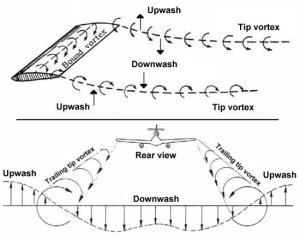
Wing tip vortices are formed because of the pressure difference between the top and bottom of the wing. For a wing generating lift, there’s high pressure at the bottom, low pressure at the top. So at the wing tip, the high pressure air below the wing tends to roll up to the low pressure region above the wing, forming two tip vortices running off trailing edge. This would subsequently cause a downwash in the middle of the span, which bends the air down as it comes off the wing. Recall that AoA is the angle between flow path and chord line, as the downwash bends the flow, effective AoA is reduced so that lift is reduced. It would also introduce a drag term called vortex drag, which is proportional to the lift and inversely proportional to aspect ratio.
On a formula 1 car, wing tip vortices can be often seen at the rear wing. However, the race car world is somehow an inversion of aeronautical world, whereby downforce and ‘upwash’ is generated.
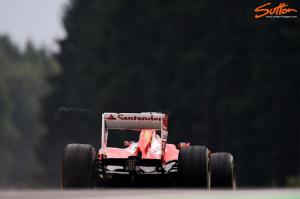
Vortex Lift
While wing tip vortices are associated with loss of lift, vortices can be used to generate lift as well. A typical case here is slender delta wings, where lift is generated from two strong leading edge vortices forming along the sharp edges. The high speed vortices reduce pressure above the wing based on Bernoulli equation so that more lift is generated from a suction effect. The vortex lift idea can also be applied to race cars on some plate components to add downforce.
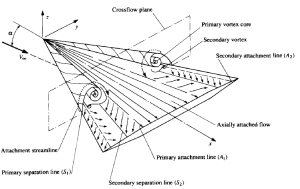
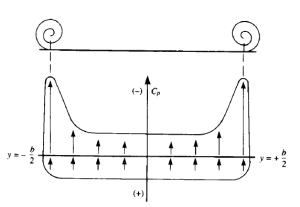
Vortices on F1 Cars
Here is a screenshot from one of the Sauber tech videos – Tech Bites: CFD – side wind, spinning car – Sauber F1 Team
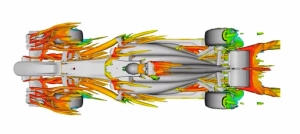
The picture here shows vorticity in the air as the car heads towards wind coming from left. Highlighted by red regions, there is high vorticity flow coming off front wing, mirror, airbox, exhaust and rear wing/diffuser. There is highly turbulent, not necessarily vortex flow coming off front and rear wheels. The famous Y250 vortex sits in the middle 250mm from centreline, governing flow towards rear of the car. There are also vortices from front wing cascades/ auxiliary wings hanging from the endplates, which manages flow above the wheel. The endplates, correspondingly, guide the airflow outbound around the wheel. With regulation change in 2014, front wing will be 75mm narrower on each sides, which would make it tricker to direct the flow around. However there’s no change related to the Y250 vortex so we can still see them next year.
Y250 Vortex
The Y250 vortex, similarly to wing tip vortices is generated because of a pressure difference, in this case between the neutral middle section (250mm from centreline) and the rest of the wing. It is very important for controlling flow approaching leading edge of the floor. Here in analogy with the delta wing vortex lift, the Y250 vortex can potentially extract air at the edge of the floor, therefore producing a suction effect that improves aerodynamics efficiency in this area. On the other hand, the Y250 vortex may also have a benefit on managing front wheel wake by pushing it away from the car.

Skysports has edited a good video comparing Y250 coming of RBR and Ferrari and talking about how well-controlled the RBR vortices is. However ‘well-controlled’ is never a good word for engineers to use. To estimate vortices, we need to use some parameters like vortex core position, vortex strength and cleanness. These parameters are what the design of complex flaps/cascades is based on. I can’t agree with the Skysports’ explanation of vortices travelling down over sidepots as the vortex strength cannot be strong enough to affect area so far downstream. Nevertheless the Y250 vortex do interact with different parts of the car, which requires careful consideration in designing of front wing, floor and turning vanes, etc.
Great blog, I myself am a mechanical engineering student currently taking aerodynamics. I wonder why F1 engineers haven’t developed some form of wing tips or by just slanting the rear vertical rudders on the spoiler to minimize the spill over.
Hi Andy thanks for the comment. And I’m an aerodynamics student as well 🙂
Hmm you kinda confused me there with the aeronautical term – by ‘rudders’ do you mean endplates? Although I may get you wrong, I think in general when you design wing tip devices, you should consider the drag penalty they cause as well. Structural reliability is another thing to think about. Also remember that F1 cars are never the best solutions, but best to conform to the rule book, which may have killed lots of good ideas!
Very nice explanation, i’m no aerodynamicist but i guess they try to replicate, as often, the mecanism that first appeared on the f16 i think, not sure though, maybe it was first developped on a russian plane the mig 29 with the so called LerX . That is to feed the low pressure area in the cock bottle shape with relative high energy stream which is a vortex. It allows greater angle of attack and less drag for a fighter jet so a better narrower sustain cornering speed to catch the vilain.
For a F1 car it would permit a narrower back shape with the same drag penalty thus enabling a better flow on the beam wing, diffuser and upper rear wing.
I was asking myself if the idea of substituting a stream flow with another as 1st seen, at least by me, on the mclaren last year with the famous coanda exhaust as a bulge above the bottle flank had any other application. And seeing the stiff angle made by the air coming underneath the nose and going around the side pod i thought i had found an area of a similar mecanism. I mean, it seems impossible for the flow to go around the bottle shape at such an angle, it must just build a strong barrier for the dirty air coming from the front wheels. That is it doesn’t go around but form a V shape that shield this area. The air substitution is on the benefit of this Y250 vortex that seems to go above the V shield and feed the bottle shape area instead. Together with a similar kind of vortex coming from the front wing end plate.
Sorry for my english.
Reblogged this on F1Blogg.com media site: and commented:
The damp weather in US Grand Prix gave us a great chance to see some ‘aero porn’. Overnight everyone’s talking about the Y250 vortex as something magical that again Red Bull managed better than others. However Y250 vortex is not a new concept – check out Scarbs post back in 2011 and SomersF1 update after Austin. Here I’m going to introduce some basic principles on vortices and explain why Y250 vortex is important. This would contain some text book material for engineering students but hopefully it will be helpful for people with general interest in aerodynamics.
Wing Tip Vortices
Let’s start with a classic textbook picture of wing tip vortices…